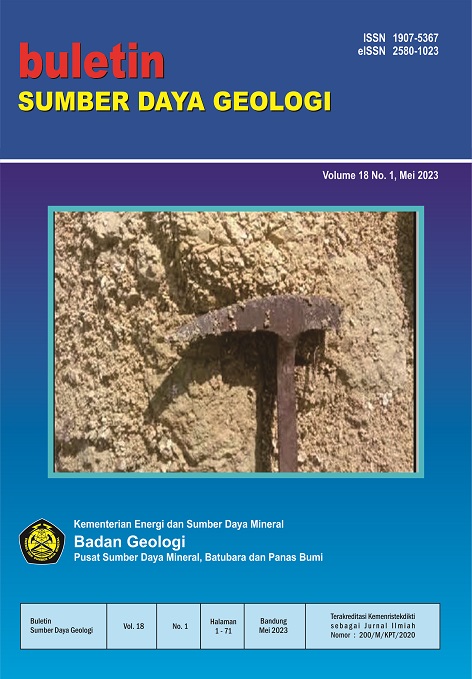KARAKTERISTIK ANOMALI GAYA BERAT DAN NILAI TAHANAN JENIS AUDIO MAGNETOTELURIK (AMT) DI DAERAH PANAS BUMI GIMPU,KABUPATEN SIGI, SULAWESI TENGAH
CHARACTERISTICS OF GRAVITY ANOMALIES AND RESISTIVITY VALUE OF AUDIO MAGNETOTELLURIC (AMT) IN GIMPU GEOTHERMAL AREA, SIGI REGENCY, CENTRAL SULAWESI
Abstract
The Gimpu geothermal area is one of the geothermal areas in Central Sulawesi. Surface geothermal manifestations are characterized by the emergence of hot springs with a temperature of 53–67 oC.Geophysics research in this area was conducted to determine the subsurface structure that describes the geothermal system in the Gimpu area. This paper discusses the characteristics of gravity anomalies and resistivity values in magnetotelluric audio (AMT) data. The results show that the distribution pattern of gravity anomalies forms a nearly north-south and northwest-southeast trending lineament. This alignment can also be seen from the results of the First Horizontal Derivative (FHD) analysis. This alignment is thought to be related to the fault structure, which controls the appearance of hot springs on the surface. The results of the 3D gravity modeling show that there is a high-density body around the Langkapa hot springs, presumably as a response from igneous rocks indicating a heat source beneath the surface. The results of 2D AMT modeling show the distribution of low resistivity values of 40 Ohm.m around the Langkapa and Karani hot springs. The distribution pattern of low resistivity values in this area is not like that in volcanic environments in general but is more like the distribution pattern of resistivity in non-volcanic geothermal areas. Therefore, the area that is estimated to be associated with the cap rock in the Gimpu geothermal system has a resistivity value of 40 Ohm.m. The low resistivity zone is located around the Langkapa and Karani hot springs, with an area of about 3 km2.
Downloads
References
Daud, Y., Nuqramadha, W. A., Fahmi, F., Sesesega, R. S., Fitrianita, Pratama, S. A., & Munandar, A. (2019). Resistivity Characterization of the Arjuno-Welirang Volcanic Geothermal System (Indonesia) Through 3-D Magnetotelluric Inverse Modeling. Journal of Asian Earth Sciences, 174, 352–363. https://doi.org/10.1016/j.jseaes.2019.01.033
Daud, Y., Rosid, M. S., Armando, A., Putranto, T. W., & Ruslita, F. M. (2018). Applying Audio-frequency magnetotelluric (AMT) and gravity technology for discovering reservoir beneath Mt. Pancar geothermal prospect. AIP Conference Proceedings, 2023(2018). https://doi.org/10.1063/1.5064275
Daud, Y., Rosid, S., Nuqramadha, W. A., Fahmi, F., Lestari, A. I., & Liati, D. (2017). Imaging Reservoir Structure of Mt. Pancar Geothermal Prospect Using Audio-Frequency Magnetotelluric ( AMT ) and Gravity Technology. 42nd Workshop on Geothermal Reservoir Engineering, 3–10.
Kusnadi, D., Hadi, M. N., Sugianto, A., & Sukaesih. (2017). Laporan Akhir Survei Terpadu Geologi, Geokimia, dan Geofisika Daerah Panas Bumi Gimpu Kabupaten Sigi, Provinsi Sulawesi Tengah. In Laporan Akhir.
Mulyani, S., Daud, Y., Pasiki, R. G., & Siagian, H. (2022). Karakterisasi Struktur Patahan pada Lapangan Panas Bumi X (Sumatra) Berdasarkan Pemetaan Geologi, Penginderaan Jauh, dan Data Gaya Berat. Buletin Sumber Daya Geologi, 17, 109–124.
Parapat, J., Hilyah, A., Utama, W., & Rahadinata, T. (2017). Pemodelan 3D Data Gaya Berat Untuk Mengidentifikasi Sumber Panas Daerah Panas Bumi Sipoholon, Sumatera Utara. Jurnal Geosaintek, 3(3), 167. https://doi.org/10.12962/j25023659.v3i3.3215
Parkinson, C. (1998). An Outline of the Petrology, Structure and Age of the Pompangeo Schist Complex of Central Sulawesi, Indonesia. The Island Arc, 7(1–2), 231–245. https://doi.org/10.1046/j.1440-1738.1998.00171.x
Pirttijarvi, M. (2004). GRABLOX: Gravity Interpretation and Modeling Software Based on a 3-D Block Model.
Rejeki, S., Rohrs, D., Nordquist, G., & Fitriyanto, A. (2010). Geologic Conceptual Model Update of the Darajat Geothermal Field , Indonesia. World Geothermal Congress 2010, April, 1–5.
Risdianto, D., Permana, L. A., Wibowo, A. E. A., Sugianto, A., & Hermawan, D. (2015). Sistem Panas Bumi Non-Vulkanik di Sulawesi. Pusat Sumber Daya Geologi.
Rodi, W., & Mackie, R. L. (2001). Nonlinear Conjugate Gradients Algorithm for 2-D Magnetotelluric Inversion. Geophysics, 66(1), 174–187. https://doi.org/10.1190/1.1444893
Setyawan, A., Yudianto, H., Nishijima, J., & Hakim, S. (2015). Horizontal Gradient Analysis for Gravity and Magnetic Data Beneath Gedongsongo Geothermal Manifestations , Ungaran , Indonesia. World Geothermal Congress 2015, April, 1–6.
Simandjuntak, T. O., Surono, & Supandjono, J. B. (1997). Peta Geologi Lembar Poso, Sulawesi.
Sugianto, A., & Rahadinata, T. (2015a). Pemodelan Gaya Berat 3D Daerah Panas Bumi Dolok Marawa Kabupaten Simalungun, Sumatera Utara. Buletin Sumber Daya Geologi, 10(2), 32–45. https://doi.org/10.47599/bsdg.v10i2.140
Sugianto, A., & Rahadinata, T. (2015b). Struktur Tahanan Jenis Sistem Panas Bumi Dolok Marawa-Sumatera Utara Berdasarkan Data Audio Magnetotellurik. Buletin Sumber Daya Geologi, 10(3), 141–151.
Sugianto, A., Takodama, I., Tony, D., Pusat, R., Daya, S., & Bumi, P. (2017). Identifikasi Struktur Sistem Panas Bumi Pantar Berdasarkan Analisis Gradien Horizontal dan Pemodelan 3D Data Gaya Berat. Buletin Sumber Daya Geologi, 12, 135–143.
Suryadi, Haerudin, N., Karyanto, & Sudrajat, Y. (2019). Identifikasi Struktur Bawah Permukaan Lapangan Panas Bumi Way Ratai Berdasarkan Data Audio Magnetotelluric (AMT). Jurnal Geofisika Eksplorasi, 3.
Villeneuve, M., Gunawan, W., Cornee, J. J., & Vidal, O. (2002). Geology of the Central Sulawesi Belt (Eastern Indonesia): Constraints for Geodynamic Models. International Journal of Earth Sciences, 91(3), 524–537. https://doi.org/10.1007/s005310100228
Xuben, W., Lanfang, H. E., Xiaoming, Z., & Nian, Y. U. (2015). Application of Geophysical Methods to the Geothermal Investigation. Fortieth Workshop on Geothermal Reservoir Engineering, Stanford University, Figure 1, 1–8.
Yuanita, E., Harmoko, U., Hananto, N. D., & Handayani, L. (2015). Karakterisasi Panas Bumi Diwak Dan Derekan Dan Identifikasi Sesar Dengan Menggunakan Metode Audiomagnetotellurik. Jurnal RISET Geologi Dan Pertambangan, 25(1), 23. https://doi.org/10.14203/risetgeotam2015.v25.131
Copyright (c) 2023 Buletin Sumber Daya Geologi

This work is licensed under a Creative Commons Attribution-NonCommercial-ShareAlike 4.0 International License.
Authors whose manuscripts are published agree to the following terms:
The publication rights of all journal manuscript materials published on the Buletin Sumber Daya Geologi website are held by the editorial board with the knowledge of the author (moral rights remain with the manuscript’s author).
The formal legal provisions for access to digital articles in this electronic journal are subject to the terms of the Creative Commons Attribution-ShareAlike (CC BY-SA) license. This means that Buletin Sumber Daya Geologi has the right to store, convert media/formats, manage in the form of a database, maintain, and publish the article without requesting permission from the author, as long as the author’s name is cited as the copyright holder.
Manuscripts published in both print and electronic formats are open access for educational, research, investigative, and library purposes. Beyond these purposes, the editorial board is not responsible for any violations of copyright law.















